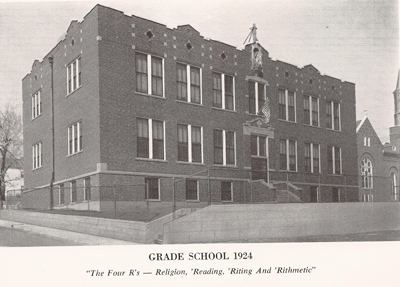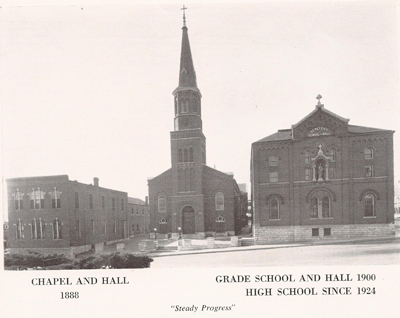Our Parish History
 The settlement of Saint Charles dates back to 1769. The first crude Catholic church was built in 1781, but a larger church, blessed in 1791, was named in honor of Saint Charles Borromeo. The city, and consequently the church, was largely composed of French Canadian settlers, but between 1830 and 1840 a large number of German settlers migrated to Saint Charles. Although they could attend Mass in the French / English church, they longed for a church in which they might pray in their native tongue.
The settlement of Saint Charles dates back to 1769. The first crude Catholic church was built in 1781, but a larger church, blessed in 1791, was named in honor of Saint Charles Borromeo. The city, and consequently the church, was largely composed of French Canadian settlers, but between 1830 and 1840 a large number of German settlers migrated to Saint Charles. Although they could attend Mass in the French / English church, they longed for a church in which they might pray in their native tongue.
Following an organizing meeting on May 6, 1848, permission was asked of Archbishop Peter Kenrick to organize a new parish and to build a two story church and school building. On September 19, 1848, the cornerstone for the church was laid and the church was named for Saint Peter, Prince of the Apostles. Construction difficulties were encountered and the first Mass was not offered until January 1, 1850, although the church was not yet finished. (Among other things, it had no pews.) Father Joseph Rauch was named pastor. Two acres of land near the city limits were purchased for a cemetery.
Following a request by the second pastor, Father Wapelhorst, the Notre Dame sisters arrived as teachers for the school in 1860. A new convent and school, east of the church, was ready when they arrived. The sisters would remain active in the parish school until 1996.
Enlarging the Church
The church was becoming too small and Father Wapelhorst urged that a new building be constructed. The parishioners, however wanted to enlarge the old church. While this expansion was taking place a storm on March 25, 1861 greatly damaged the building. It was then necessary to build a new church, and on June 13, 1861, the cornerstone for a 120 by 55 foot Romanesque style building was laid. By December 18, 1861, the church, which is the main body of the church you see today, was dedicated. It was practically complete except for the steeple. At that time it was one of the largest Churches west of the Mississippi River and was consecrated by Archbishop Kenrick on September 4, 1864. The first assistant priest arrived in 1865.
In 1867, the building of a new school and a rectory, west of the church, was started. The old school was converted into a residence for the nuns. The rectory, completed in 1868 served the priests until 1935 and later became a part of the high school. The steeple of the church was completed and the tower clock installed in 1872. The organ, used by the church until 1947 when the current organ was installed, was also bought in 1872.
 Father Francis X. Wilmes became Pastor of the Parish on January 1, 1882 and remained for 50 years. (In 1896, the Parish received the distinction of having an irremovable pastorship, a practice discontinued by the Church in 1917.) He was instrumental in making many changes to the Parish. Immediately, donations were secured for new church windows. An additional eight acres of land were added to the cemetery. In 1885, a new steam heating system was installed in the church. But to avoid the cost of heating the church for week day Masses in the winter, and so that the numerous parish societies would have suitable meeting quarters, a two story chapel and hall were erected east of the church in 1888. The hall, on the second floor, included a stage. Later, because of additional growth of the church and school, a new school and auditorium, on the site of the old school west of the church, was dedicated on September 23, 1900. The old hall was converted into a residence for the sisters. The Young Men’s Dramatic Club used these facilities for presenting plays and for their club meetings. Bowling alleys were installed in the basement club rooms in 1903. This building and the old rectory building were razed in 1983.
Father Francis X. Wilmes became Pastor of the Parish on January 1, 1882 and remained for 50 years. (In 1896, the Parish received the distinction of having an irremovable pastorship, a practice discontinued by the Church in 1917.) He was instrumental in making many changes to the Parish. Immediately, donations were secured for new church windows. An additional eight acres of land were added to the cemetery. In 1885, a new steam heating system was installed in the church. But to avoid the cost of heating the church for week day Masses in the winter, and so that the numerous parish societies would have suitable meeting quarters, a two story chapel and hall were erected east of the church in 1888. The hall, on the second floor, included a stage. Later, because of additional growth of the church and school, a new school and auditorium, on the site of the old school west of the church, was dedicated on September 23, 1900. The old hall was converted into a residence for the sisters. The Young Men’s Dramatic Club used these facilities for presenting plays and for their club meetings. Bowling alleys were installed in the basement club rooms in 1903. This building and the old rectory building were razed in 1983.
Because the Parish continued to grow, the church needed to be enlarged again in 1910. Work began in March and the first Mass celebrated on September 25. The addition consisted of the current sanctuary, two large sacristies and a transept. The high altar, which had been obtained in 1887, was refurbished and placed in the new sanctuary, where it still remains. The addition brought the length of the church to 164 feet. The stained glass windows in the sanctuary were installed in 1912. The parish was blessed to have two assistant priests beginning in 1915.
Because of steady growth in the school, a new building was dedicated August 31, 1924. The prior grade school building was converted to a high school. The high school began as a two year school and was converted in 1929 to a four year school which existed until the establishment of Duchesne High School in 1956.
Father Anthony Strauss became pastor in 1932 and would remain for 34 years. In 1935, the current rectory was built, with the old rectory becoming part of the high school. In 1944 the church was extensively remodeled. New lighting, a new tabernacle, new confessionals, ceiling insulation and a complete repainting were included. A new organ was installed and the choir loft remodeled in June, 1947. A new convent for the sisters was dedicated July 3, 1949.
New Additions and Replacements
An addition, including classrooms and a cafeteria, was made to the grade school in 1960. The church was again repainted and new pews and carpeting were installed in 1972. A recent addition to the parish grounds was the construction of the Parish Center which was dedicated on November 17, 1985.
In April 1998, a building was begun which included two classrooms and rest rooms in the lower floor and a Chapel and gathering space or vestibule and rest rooms on the upper floor. A ceremony of blessing for the Chapel building was on January 1, 1999. The two stained glass windows in the Chapel sanctuary area were installed in May 2000. The remaining stained glass windows were installed in the east chapel wall in January 2002.
 New pews and carpeting were installed in the Church in August 1999.
New pews and carpeting were installed in the Church in August 1999.
Saint Peter Parish celebrated the Sesquicentennial Mass on Pentecost, June 11, 2000.
The convent building was converted to a Day Care and Early Learning Center on the first level and additional school classrooms on the upper level in 2002.
In 2008 the statues in church were repainted. The sanctuary carpeting was replaced with hardwood and a new altar was installed and consecrated.
Because of the necessary brevity, this summary cannot make note of all of the great work performed by all of the former pastors and parishioners of Saint Peter, but their legacy to us is greatly appreciated.
The following major projects were undertaken as part of the Capital Campaign 2006 Preserving our Heritage:
- 2007 Replaced the original rectory roof from 1935.
- 2008 The entire church was tuck-pointed.
- 2009 A new standing seam roof was installed on the church. All the windows were replaced in the 1960 addition of the school. A new high efficiency boiler replaced the 74 year old boiler in the rectory.
- 2010 The main parking lot at 2nd street & 1st Capitol was resurfaced.
In 2012 all stained glass windows in the church were removed and completely restored.
The church interior wall cracks were repaired and the interior was completely painted, lighting replaced and new flooring installed.